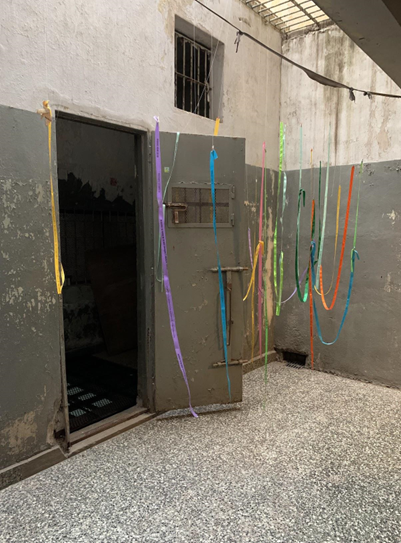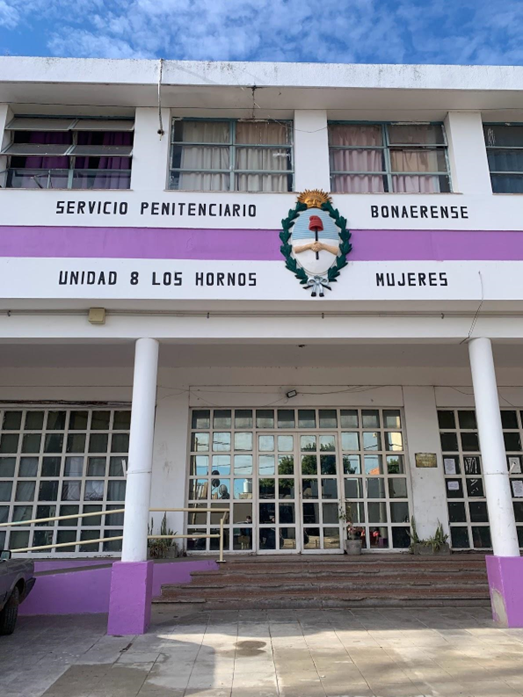
Visiting Pozo de Quilmes, a previous clandestine detention center, at the start of my second week in Argentina also marked the beginning of my internship with the Mecanismo.
Following an onboarding process in which I gained an overview of Argentina’s penal institutions, I began my work with the Programa Recepción de denuncias. Within this program, I worked with the team responsible for being the primary point of contact for individuals or family members calling on their behalf who were experiencing human rights violations while incarcerated. I quickly learned that “torture” is highly nuanced, and various situations can qualify as human rights abuses that, for me, have always existed beneath one umbrella word: torture. It is critical, however, to document all human rights violations so that when the presiding judge receives their case, they will be presented with substantial evidence and documentation, hopefully affecting a change.

Concerningly, aislamiento (solitary confinement) was among the most frequent human rights violations I saw while recording information into a computer program called Savit. Additional violations included unsafe or precarious electrical connections within cells and shared spaces leading to high electrocution risks; and little to no access to medical treatment. In some instances, anesthesia was withheld as a manner of torture.

After working with the Programa Recepción de denuncias, it was time to move into the next stage of my internship: Programa Inspección de lugares de encierro. I read various Informes (reports) within this team and a writ of Habeas Corpus. Before visiting Unidad Penitenciaria N॰8 -a prison annex for women- I created a Pre-Informe, which included an overview of the prison’s past human rights violations and information about the women to be interviewed.

When I first entered UP N॰8, I was met with a religious statuette. Outside of the Cathedral de La Plata, I had not seen many religious symbols or paraphernalia in the city; however, there were cross symbols in the doorways throughout the prison. I wanted to explore whether this was a common occurrence in other prisons or an exclusive circumstance. Upon further discussions with my host family, I learned that these religious symbols are not for those detained, but rather for those who work there -as they only exist within the entrance of the prison. Among those detained, Evangelism is more common than Catholicism; and is practiced more often in male prisons. A popular saint is Gauchito Gil who is present in many of the prisons; while he is not recognized by any church, he is a saint amongst people.

While waiting for my supervisor, Juan Introzzi -the Director of the Programa Inspecciónes, I watched as a police truck pulled up to the main entrance, and four SPB officers exited the vehicle and escorted a woman, in handcuffs, through the door. This scene was the first time in my life that I had watched someone in handcuffs escorted into prison.
I did not see a female doctor during my entire time in prison -over four hours. I did, however, see numerous male doctors, which struck me as odd since the prison’s only occupants are women.
Outside of the three women interviewed, I also met with a few women in the center for students. In this section of the annex, women can work towards achieving a degree through the local university while having access to at least four computers and numerous learning materials. For a moment, it was as if we were not in jail and these women were fellow students until we were interrupted by an SPB agent slamming open the door. Unfortunately, this interruption was not a one-off. While the interviews were being conducted, the shadow of an SPB officer could be seen -during the entire duration of the discussions- beneath the door. This door was completely insufficient for privacy. It was broken and not entirely flush with the floor and connected the interview room to the SPB agents’ breakroom. At one moment, a cup fell on the floor and rolled under the door. While the SPB agent vocally apologized, they reached under the door to retrieve the missing kitchenware, further disrupting the interview. Sadly, this incident did not startle the women being interviewed, as one of the women said, “Pasa todo el tiempo” (“It happens all the time”).
The next day, I wrote a Post-Informe detailing the interviews with the women and my interactions with the prison in general. Next week, I will begin the latter portion of my internship and begin work with the Programa Salud mental.
In my free time these past two weeks, my host family held an asado with the other William & Mary human rights interns and took me to a Santiago Motorizado concert! I visited the top of the Cathedral La Plata and the museum below. Fati and Lucho have been invaluable to me in terms of their aid in adapting to the culture and learning the nuances of Argentine Spanish. I am delighted to be immersed in this family and my day-to-day life here in Argentina; I am not looking forward to leaving.




Of everything I have experienced in La Plata thus far, I have some key takeaways: undergraduate school is free here, as is healthcare -including abortions and birth control. There are exceptions to this, as living in the city where one’s university is can cost a considerable amount of money -especially if you are from a town far from the nearest university. Healthcare functions much in the same way, as even if healthcare may be free or available at a reduced rate, accessibility varies tremendously. La Plata has a fair amount of hospitals, pharmacies, and clinics; however, this may be nonexistent in a small town. There is still much that I need to learn here; I am incredibly grateful to have the opportunity to do so over the next few weeks.
Adiós for now!
